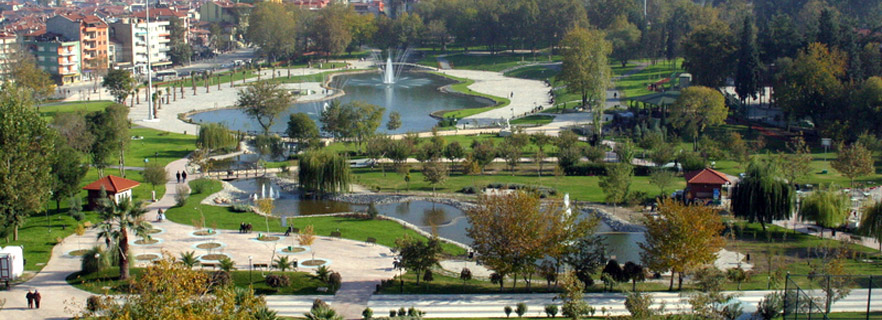
Denizli Province is a province center in the Aegean Region. Denizli is the largest city in the Aegean region after İzmir, with its central population exceeding 500 thousand. Denizli is one of the biggest and most developed cities of Turkey (city center: 537,000). Denizli, an industry, export and trade center, is also a university city with a population of over thirty students. Having hosted millions of local and foreign tourists in a year, Denizli is a tourism city, as well as educational, congress, cultural and artistic center with local, national and international events (see festivals). The center of the Southern Aegean Development Agency (Geka) is also Denizli.
Denizli is a new city, located on a plateau where the slopes of the north slopes of Akdağ (Babadağ) reach the Aksu stream which is the branch of Büyük Menderes. Up to the 11th century there was a water-rich settlement called "Laodicaea on the Sea". The actual city was Laodicea (Laodicaea), about 6 to 7 kilometers north of here. The wars between the Seljuks and the Byzantines began to be abandoned in time, and Laodikeia, especially after the destruction of the waterways, began to be abandoned and the settlement began to move towards the Denizli Ladik where the abundant water resources were found starting from the 11th century. The city suffered great damage during an earthquake in 1702-1703 and was later rebuilt. Located on a natural route through the Aegean coast, Denizli has been rapidly crowded with the development of agricultural activities in and around its location, especially after the improvement of highways in the 1950s, and the population of 22,000 in 1950 has increased by more than 20 times over the past 60 years.
Denizli is one of the most developed cities of Turkey. It is Anatolian Tigers. It is among the most important capitals of textile in the world. Denizli is among the top ten economies of Turkey. The city has good prestige in US and EU market in towels, bathrobes and home textiles. Its air and nature reflects the averages of the Aegean region. The governor is Yavuz Erkmen, Mayor Osman Zolan.
It is famous for the daughter and the rooster with the saying among the people; At a few points in the city are found cock statue. Pamukkale is one of the symbols of the city. Pamukkale is on Unesco's list of world cultural heritage. Karahayit is also an international thermal center. In addition, Honaz Mountain is the highest mountain in the Aegean region at the same time (2532 m). Hierapolis, Laodicea, Tripolis and so on that enter UNESCO in the city. There are many ancient cities. After the mayor of Nihat Zeybekçi was a candidate for parliament in 2011, he was again the leader of Justice and Development Party Osman Zolan.
Education
The literacy rate of Denizli is around 94%. Due to the high importance given to the trainings, especially the ÖSS has a permanent place in the first 3 ranks (mostly 1st place) every year in order of success in the entrance examinations for secondary education and university entrance examinations such as SBS. For this reason, Denizli province has a high education level and quality throughout the country and has an image known by its successful students. Pamukkale University, which was established on July 3, 1992, has brought dynamism and vitality to Denizli from a socio-economic and cultural point of view. With more than 31,000 university students, Pamukkale University is growing day by day. Rapidly built Pamukkale University Kınıklı campus is close to being one of Turkey's best campuses in the near future.
Economy
The economy of Denizli is based on industrialization and commercialization. Denizli is an export and industrial city. The service sector has also grown considerably. In the last 15 years, the industry has shown a great improvement. He exported copper wires to the US. 45% of the active population is engaged in agriculture, fisheries, beekeeping, forestry and animal husbandry. 30% of all revenue comes from the industry. It is one of the leading exporter cities known as Anatolian Tigers in Turkey. It is one of the locomotive industrial cities of Turkey with billions of dollars of exports every year. Although Denizli is known as the capital of Turkey in the world and in the world, economical balances have shifted over the marble and natural stone sector due to economic losses experienced in textile in recent years. Denizli is exporting marble and natural stone which are travertine and derivative to all countries of the world.
Agriculture
Marine farming is very convenient. Main agricultural products; Wheat, barley, walnut, corn, chickpeas, tobacco, poppy, grapes, figs and pans. Vegetable production is 250 thousand freezes. After grape, melon, watermelon, apple, pear, cherry, cherry, peach, almond, plum and pomegranate is abundant.
Pistachio production is increasing day by day. An average of 1000 tons olives are obtained from 120.000 olive trees. All of the available water potential cultivated land is suitable for irrigation. An important part of the cultivated land is irrigated. There are 95,000 fig trees ...
Industry
Industry is developing rapidly. The weaving and metal industry is at the forefront. Major major industrial enterprises are; Dentaş Packaging Industry, Er-Bakir Electrolytic Copper, Denizli Cement, Paşabahçe, Kardemir Haddecilik, Eke Metal, Menderes Textile, Aynes Food, Ayyem Agri, Tosunoglu Textile, Integro, Tümteks Textile, Gökhan Textile, Kaynak Group, Abalıoğlu Yem, Ugurlu Auto Glass , Zorlu Holding Taç ve Linens, Lezita, Değirmenci Group, Evliyaoğlu Textile, Aysan Decorative Shelf Systems, Pamukkale Cable, KONMAK, Erikoglu Textile, DEDA Leather Industry, ADA Underwear, Marine Textile, FABER, AKÇA Concrete, Altınbaşak, İnceoğlu Factory, DEPAŞ Prefabricated, AKMETAL Wrought Iron ... Apart from these factories, also shoes, cable, nut, bolt, brick, plastic, chipboard, cardboard, oxygen gas, glass products, cotton products, feed, nuts, flour, lime, engine parts, , Furniture and marble, food, plate manufacturing industries and facilities.
Transportation
There is Denizli Çardak Airport. THY carries out mutual Denizli-Istanbul flights. Direct mecca services are also available during the times of the year. There are many bus companies in Denizli that are located at the junction of our important cities such as İzmir and Antalya in land transportation. There are 7 bridged junctions and 2 tube gateways.
Flora
Half of Denizli is covered with forests by 59%. Meadow and meralar are 10%, cultivated and planted land is 43%. Only 1% is not available.
Ilin vegetation is mostly forest trees and Mediterranean climates bring to the water. The forests include black pine, red pine, cedar, juniper, oak, beech, plane and ash. The broad areas of the mountain skirts under the borders of the forests are covered with bushes and bushes.
Tourism
Pamukkale: Pamukkale is a heavenly corner made of the lime of spring waters. It is Turkey's most well-known natural wonder. More than 1.5 million local and foreign tourists visit Pamukkale every year. Pamukkale is 2700 meters in length and 160 meters in height. It is possible to see Pamukkale from a distance of 50 km with its bright white color. Also in Pamukkale, Hierapolis ancient city, ancient pool, ancient theater, archeology museum is the place to visit. At the top is the ancient city of Hierapolis, an ancient Roman city. Near the ancient city of Laodice is located 5-10 km. 5 km further away is Karahayıt, an international thermal center. There are many ancient cities outside of them in Denizli. Keloğlan and Kaklık caves are other tourist attractions that must be seen. Five and four star hotels in Pamukkale and Karahayıt region, pensions provide thermal tourism and spa services.
History
Denizli city was established for the first time around Eskihisar Village, 6 km north of today's city. This city is BC. (261-245), the King of Syria II. It was founded by Antiochustheos and it is called LAODICIA on behalf of his wife. After the Turks captured the Denizli weather, they transported the city to the present Kaleiçi site where the water is abundant.
In the name of Denizli, we find other names in historical sources. The records of Seljuk and the court of Denizli (Ladik) (laodikeia) give the name. Ibni Batuta's travelname (Tunguzluğ) is called. It was also recorded in Mesalikullebsar (Tunguzlu).
He speaks of two names, such as Şerafettin Zemdi (Tenguzlug) and (Tonguzlug), who wrote the names of the victories of Timurlenk. Uncensored word refers to Sea in old Turkic language. Tunguzlu means Denizli with its present symbol. As a result, the names of Denizli, Tunguzlu and Tunguzlu have taken their present shape with the passage of time from their mouths, becoming Denizli words.
Denizli in the 18th and 19th centuries
In the 16th and 17th centuries, the Denizli Accident, which is connected to the center of Anatolian State in Kütahya Sanjak in 1451, is divided into four sections, namely Nahiye-i Lazikiyye (Center), Nahiye-i Ibsi, Nahiye-i Kaş-Yenice and Nahiye-i Aydos It consisted of the divine.
In the region of the central district of the city of Nevşehir, the district of Ibişili, Buldan and Güney, Aydos is an area extending to Ulubey, Eşme and Alasehir in the north of Uşak, to the vicinity of Kiraz in the west of Aydin. .
These Nephews became an accident in the 17th century and took the name of Ibsili Nahiyesi: Ezine, Kaş-Yenice Nahiyesi: Çarşamba (Cıharmakba). In the 16th century, Aydos began to be known as the Gök-Öyük Accident. Participated in the accident named Honaz'a, the number rose to five.
At the end of the 18th century it is seen that the name of Buldan is sometimes passed on documents related to Avarız and Bedel-i Nüzul, Imdâd-ı Seferiye and Hazariye taxes. In 1213 (1798), a sailor's book is listed as follows: Kazay-ı Denizli, Kazay-ı Ezine, Kazay-ı Buldan, Kazay-ı Honaz, Kazay-ı Gök-Öyük. It is noteworthy that Buldan was written instead of the accident in the book.
In the distribution books in Denizli Şer'iye Siciller, 26 villages contributing to the city's annual costs and taxes were recorded. Bekirli is the village with the least tax deducted from this tabloda feeling that Karcı village is in the first place. The Karcı has taken the name of Başkarcı today. Among the sources of income are woven looms made of walnut wood that Denizli hand weaving has become famous for centuries of fabrics produced on these looms.
In addition to the above-mentioned villagers, some evidence from the records of the sherries from 1781 shows the names of the villagers named Eldeniz, Şamlı Kebir. Eldenizli from these villages, who seemed to pay an average of 50 pennies a year, took the names of Şamlı Kebir and Şamlı Sagir, Lower and Upper Sami while continuing their existence with the same name.
Continuing to be an accident connected to the Kütahya Sanjak during the 18th century, Denizli became a banner on the division of the Anatolian Beylerbeyi in the 19th century and was connected to the newly established Aydın Sancağı. Denizli, which was joined with Menteşe after the arrangement of 1867, joined Aydin Sanjak as an accident but in 1883 Denizli sanjak was re-established as a mutasarrifership and reached to the widest borders of Ottoman period with the participation of Tavas in 1884 and Garbi Karaağaç (Acıpayam) in 1888 . In this period, the number of villages of Denizli, which consists of 6 accidents and 1 nativity, reached 385.
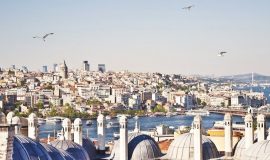

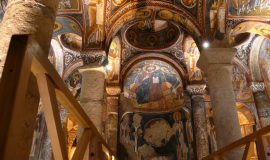
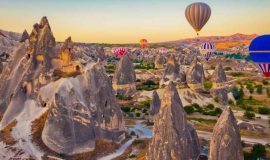

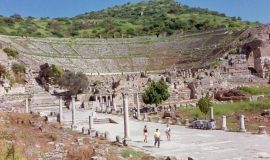
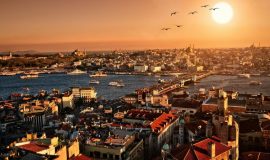
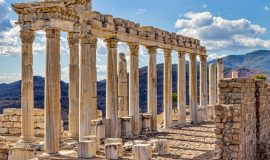
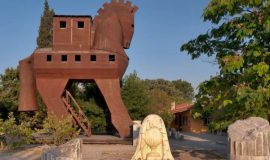
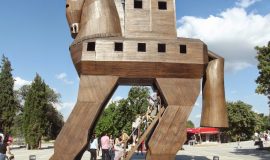
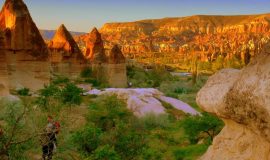

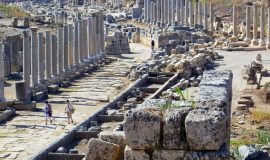
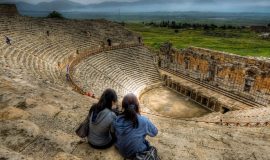

 Denizli Province is a province center in the Aegean Region. Denizli is the largest city in the Aegean region after İzmir, with its central population exceeding 500 thousand. Denizli is one of the biggest and most developed cities of Turkey (city center: 537,000). Denizli, an industry, export and trade center, is also a university city with a population of over thirty students. Having hosted millions of local and foreign tourists in a year, Denizli is a tourism city, as well as educational, congress, cultural and artistic center with local, national and international events (see festivals). The center of the Southern Aegean Development Agency (Geka) is also Denizli.
Denizli is a new city, located on a plateau where the slopes of the north slopes of Akdağ (Babadağ) reach the Aksu stream which is the branch of Büyük Menderes. Up to the 11th century there was a water-rich settlement called "Laodicaea on the Sea". The actual city was Laodicea (Laodicaea), about 6 to 7 kilometers north of here. The wars between the Seljuks and the Byzantines began to be abandoned in time, and Laodikeia, especially after the destruction of the waterways, began to be abandoned and the settlement began to move towards the Denizli Ladik where the abundant water resources were found starting from the 11th century. The city suffered great damage during an earthquake in 1702-1703 and was later rebuilt. Located on a natural route through the Aegean coast, Denizli has been rapidly crowded with the development of agricultural activities in and around its location, especially after the improvement of highways in the 1950s, and the population of 22,000 in 1950 has increased by more than 20 times over the past 60 years.
Denizli is one of the most developed cities of Turkey. It is Anatolian Tigers. It is among the most important capitals of textile in the world. Denizli is among the top ten economies of Turkey. The city has good prestige in US and EU market in towels, bathrobes and home textiles. Its air and nature reflects the averages of the Aegean region. The governor is Yavuz Erkmen, Mayor Osman Zolan.
It is famous for the daughter and the rooster with the saying among the people; At a few points in the city are found cock statue. Pamukkale is one of the symbols of the city. Pamukkale is on Unesco's list of world cultural heritage. Karahayit is also an international thermal center. In addition, Honaz Mountain is the highest mountain in the Aegean region at the same time (2532 m). Hierapolis, Laodicea, Tripolis and so on that enter UNESCO in the city. There are many ancient cities. After the mayor of Nihat Zeybekçi was a candidate for parliament in 2011, he was again the leader of Justice and Development Party Osman Zolan.
Denizli Province is a province center in the Aegean Region. Denizli is the largest city in the Aegean region after İzmir, with its central population exceeding 500 thousand. Denizli is one of the biggest and most developed cities of Turkey (city center: 537,000). Denizli, an industry, export and trade center, is also a university city with a population of over thirty students. Having hosted millions of local and foreign tourists in a year, Denizli is a tourism city, as well as educational, congress, cultural and artistic center with local, national and international events (see festivals). The center of the Southern Aegean Development Agency (Geka) is also Denizli.
Denizli is a new city, located on a plateau where the slopes of the north slopes of Akdağ (Babadağ) reach the Aksu stream which is the branch of Büyük Menderes. Up to the 11th century there was a water-rich settlement called "Laodicaea on the Sea". The actual city was Laodicea (Laodicaea), about 6 to 7 kilometers north of here. The wars between the Seljuks and the Byzantines began to be abandoned in time, and Laodikeia, especially after the destruction of the waterways, began to be abandoned and the settlement began to move towards the Denizli Ladik where the abundant water resources were found starting from the 11th century. The city suffered great damage during an earthquake in 1702-1703 and was later rebuilt. Located on a natural route through the Aegean coast, Denizli has been rapidly crowded with the development of agricultural activities in and around its location, especially after the improvement of highways in the 1950s, and the population of 22,000 in 1950 has increased by more than 20 times over the past 60 years.
Denizli is one of the most developed cities of Turkey. It is Anatolian Tigers. It is among the most important capitals of textile in the world. Denizli is among the top ten economies of Turkey. The city has good prestige in US and EU market in towels, bathrobes and home textiles. Its air and nature reflects the averages of the Aegean region. The governor is Yavuz Erkmen, Mayor Osman Zolan.
It is famous for the daughter and the rooster with the saying among the people; At a few points in the city are found cock statue. Pamukkale is one of the symbols of the city. Pamukkale is on Unesco's list of world cultural heritage. Karahayit is also an international thermal center. In addition, Honaz Mountain is the highest mountain in the Aegean region at the same time (2532 m). Hierapolis, Laodicea, Tripolis and so on that enter UNESCO in the city. There are many ancient cities. After the mayor of Nihat Zeybekçi was a candidate for parliament in 2011, he was again the leader of Justice and Development Party Osman Zolan.











